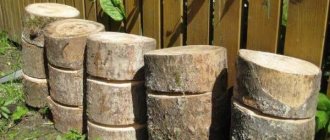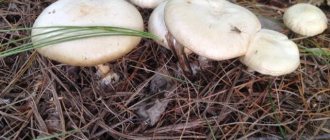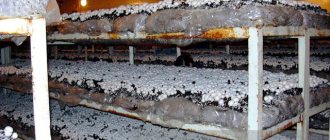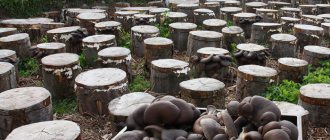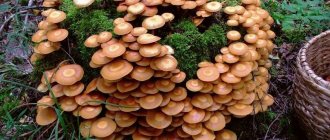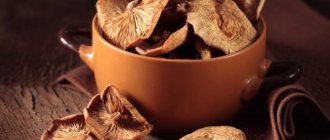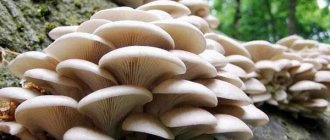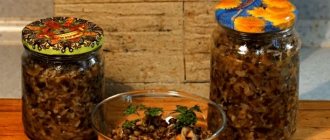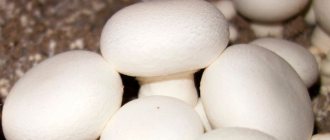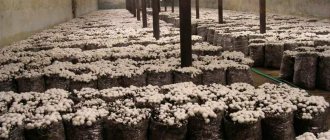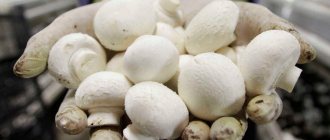What honey mushrooms are grown at home?
If you are thinking about how to grow honey mushrooms in the country, first you need to think about what time you want to do this. Because only winter and summer species can be bred under artificial conditions. The winter variety is often chosen because it requires less space and costs less to grow.
As a rule, summer mushrooms are grown outside. Open air is suitable for this - a garden or summer cottage, as well as a vegetable garden in a private house.
Summer mushrooms grow well under natural conditions and do not require additional care. If you plan to grow more mushrooms, you can plant them in a barn or cellar.
Many people don’t know how to grow winter mushrooms. Many people are surprised by growing honey mushrooms in a jar, but this is how the winter species is propagated.
The substrate is poured into the container and then placed in a warm room. The temperature for comfortable growth of mushrooms should be in the range from 12 to 25 degrees. An insulated balcony or basement is suitable.
The air in the room should be sufficiently humid, but ventilation is required. Mushrooms can grow in the dark, but this will affect their appearance. Therefore, it is better to provide them with natural or artificial lighting, albeit not so bright.
LiveInternetLiveInternet
Honey fungus is an edible mushroom that lives on and around rotten stumps, fallen trees. Honey mushrooms are known for their ability to grow in large groups, sometimes covering the entire stump. Popular among mushroom pickers because they are rarely wormy, tasty, and versatile in preparation. They are interesting to collect: sometimes entire fallen trunks are covered with mushrooms. Of course, every mushroom picker wants to have a small plantation of honey mushrooms in their garden. Summer and autumn honey mushrooms are grown, but there are no differences in breeding techniques.
If you have an old stump on your property, it is good to use it as a starting point for breeding honey mushrooms. Oak, maple, poplar, and willow are suitable, but most often honey mushrooms grow on birch and aspen rotten trees. There are two ways to plant mushrooms on a plot. First: the caps of old mushrooms are soaked in water (not purified, rain or from a river, not cold). After a day, the water will turn into a broth rich in fungal spores. Water the stumps with it. Place the ripe mushroom caps on top. The second way is to bring a piece of rotten wood from the forest from the place of the stump where honey mushrooms grew. Nail it to an existing stump and water it. A piece of mycelium will grow into a new stump.
Honey mushrooms need to be planted in warm weather. The main thing is not to let the plantings dry out for a long time. The mushroom bed should be watered as needed, not only in the fall, but also in the summer, since the mycelium needs good conditions to take root and grow a crop. Maintaining humidity is the key to success.
To prevent the stump from drying out and the mushrooms from frying in the sun, the area around it should be planted with tall shady plants such as ferns or nettles. If you don’t have a stump on your property, use large logs and sawdust instead. Carefully chop the logs in several places with an ax and bury them halfway into the ground. Sprinkle sawdust around and mix a little with soil. This is also a great way to expand your plantation if you don't have many stumps on your property.
It takes a mycelium a couple of years to colonize a new home and grow crops. Unnecessary rotten wood, branches and shavings will serve as additional food for the mycelium if you place them between the stumps. The mycelium can even feed on potato tops! If the bed is in a sunny place, cover it. Only in such a way that ventilation is maintained and rain moistens the soil around the stumps. For this purpose, you can make grooves in the ground leading to logs/stumps.
By growing honey mushrooms on your plot, you will not only be able to easily harvest several buckets of the crop, but also control the growth of the fruit. And you will also know when a new wave of mushrooms has started and you will go into the forest just in time. The only caveat is that the mycelium sometimes infects living plants, inhibiting them. Therefore, do not arrange a mushroom bed near fruit and berry trees.
https://moi-8sotok.ru/publ/griby/opjata/priruchaem_...stit_opjata_na_dache/19-1-0-18
Growing on stumps
If there are stumps on the territory, then you can start growing honey mushrooms on the stumps. Birch or spruce remains are suitable for this, but not rotten ones.
They should be fresh, dense, without dust. Mushrooms grow best on a damp surface. You can tell whether a stump is wet or not by the amount of moisture that has formed on its surface.
If the stump is dry, you can prepare it for the growing process by starting to water it a day or two before planting the mushrooms.
You need to do this in small portions so that the water has time to be absorbed. It is best to sow in May; the weather at this time is optimal for growth.
Selecting a location
The area where it is planned to breed honey mushrooms must have stumps from trees such as aspen, pine or birch. Although, stumps from any other trees are quite suitable. The stumps must be large in size (the larger the diameter of the stump, the longer the honey mushrooms will feed on it, destroying the stump, and, accordingly, bear fruit). Before adding the material from which honey mushrooms will grow, the stumps should be pre-prepared. First of all, the wood of the selected hemp should not be infected with other types of parasitic fungi. It should also be dense and quite wet. A stump that is suitable for growing honey mushrooms should be dark in color - this indicates the humidity necessary for this activity. It is also necessary to achieve moisture inside the entire stump structure. To do this, a few days before the stump is infected with honey mushroom material, you should regularly and often water the stump with water (from a bucket or a hose - it makes no fundamental difference).
How to plant honey mushrooms on a stump
Growing mycelium of honey mushrooms or other planting material on a stump is carried out as follows:
- You need to make several notches on the stump; this is done using tools, such as a hammer or chisel. You need to make about 10 holes, usually guided by the size of the stump. You must not overdo it and not punch through the stump to such a state that it will fall apart after some time;
- Seed material is placed in the recesses made with a chisel, and damp small shavings or sawdust are sprinkled on top. You can cover the stump with film to speed up the germination process. You just need to make sure that the stump underneath does not rot or become moldy. You can also cover the top of the stump with branches and sawdust.
In the best case scenario, the harvest can be harvested in the fall. Sometimes mushroom growth can only be noticed the following year. From such a stump the harvest can be harvested for up to 8 years in a row.
Growing methods and technologies
Planting using any technology will allow you to grow aromatic mushrooms that are not inferior in quality to their forest counterparts. The harvests can be generous, and the cultivation process itself will be profitable and exciting.
On the stumps
It is better to grow mushrooms on the remains of trees in the open air during the warm period (April–September). Mushrooms can be grown indoors using this method all year round. In the garden, the planting site is chosen in partial shade.
Important! The tree must be cut down a maximum of 30 days before planting the mycelium.
In this case, stumps of the following crops are used for planting:
- acacia;
- birch;
- beech;
- hornbeam;
- pear;
- aspen;
- poplar;
- Apple tree.
The stump should not show signs of rotting, it should be well moistened and have no branches . The presence of bark is allowed. If the stump or log is dry, it can be soaked in plain water for 2–3 days. Then they leave it in partial shade for several days so that the stump is ventilated and excess moisture is removed.
Holes 0.8–1 cm wide and 5–6 cm deep are made in the prepared hemp. The mycelium will be placed in these recesses. After placing the mycelium, the excavations are covered with pine needles or moss. To maintain a sufficient degree of moisture, the soil near the stump needs to be moistened from time to time.
We recommend that you read our electronic magazine about growing mushrooms at home.
You can hope for the results of planting next summer, and you can collect mushrooms for 5–7 years from the moment of planting, until the stump completely falls apart. In the first years, the harvest will not be very abundant, but over time it will increase by 2–4 times.
Method of laying mycelium on a wood base:
1 - Drill 20 holes with a diameter of 10 mm and a depth of 5 - 6 cm in a checkerboard pattern on the prepared log, without touching the core; 2, 3 - Insert sticks with mycelium into the holes until they stop and cover with plasticine or wax. Make sure that no debris gets into the wood; 4 - On the surface, in places of infection, traces of mycelium are visible; 5 - Logs completely covered with a coating of mycelium are planted in a permanent place of fruiting. The main disadvantage of this method is the fact that the mycelium sprouts slowly , therefore, to maintain and activate its growth, it is recommended to cover the hemp with film. The positive thing is that this method does not require serious financial investments, and the process itself is easy to implement for any beginner.
Did you know? Honey fungus is considered a parasitic mushroom. It can affect about 200 species of trees and shrubs. It can even parasitize herbaceous plants.
On the straw
Straw serves as an excellent substrate for cultivating honey mushrooms . Any grain straw can be used (barley, oats, rye, etc.). Before use, it is better to crush it (pass it through a crusher) or simply grind it. The smaller the particles, the greater the moisture capacity of the substrate.
Chopped straw is placed in a container. 12 hours before planting the mycelium, the straw is steamed in hot water. You can add a combined mineral supplement to the liquid. After the straw has cooled, mycelium is added to it and mixed well.
The infected substrate is laid out in plastic bags, placed on shelves or hung. After 3–4 days, 5–6 cm long slits are cut in the bags. After 14–20 days, the honey mushrooms will germinate.
1 - moistening and mixing the substrate; 2 - mixing the pasteurized substrate with mycelium; 3 - making cuts on a bag filled with seeded substrate; 4 - placement of blocks for growing mushrooms on racks with vertical hanging.
- Disadvantages of this method:
- the method is labor-intensive;
- a separate room is required.
- Among the advantages of this method are:
- bags with obsolete mycelium are easier to replace;
- if the mushrooms are affected by rot or infection, the packages can be quickly removed, thereby avoiding contamination of the entire plantation;
- the ability to place packages in tiers, thereby saving space.
Did you know? The largest organism on Earth is the honey fungus, which grows in Oregon (USA), in the Malheur National Wildlife Refuge. Body size is 890 hectares. It was not possible to establish the exact age, but, according to scientists, the mushroom is 2000–8000 years old. At first it was believed that the area was inhabited by different clusters. But a more detailed study revealed that this is a single organism.
On sawdust
The main advantage of this method: you can use a house or city apartment for cultivation. This means that it is possible to grow mushrooms not only in summer, but also in winter. The main disadvantage is the fact that sawdust must be disinfected.
You can cut mushrooms after 45 days. One three-liter jar will yield about 1500 g of mushrooms.
The process itself goes like this:
- Two parts of crushed sawdust (3–4 mm in size) and part of small shavings are mixed and boiled. Then you need to let the moisture drain.
- When the mixture has cooled, nutritional components are added to it. For 1 kg take: 8 g of starch, 25 g of oatmeal and corn flour.
- Place the mixture 2/3 full in glass containers (these can be 1, 2 and 3 liter jars) and lightly compact them. The jars are then placed in a large container and boiled for two hours.
- When the sawdust has cooled to +25°C, use a sterile twig to make holes 5–7 cm deep. The mycelium should be planted there.
- After filling all the holes, the containers are sent to a dark place with a constant temperature of +24°C and a humidity of 80–85%.
To retain moisture in the substrate, the home mushroom garden is covered with lids with slots and cotton wool on top. After the mycelium sprouts, the temperature is lowered to +14…+16°C.
Find out also how to grow champignons and oyster mushrooms at home.
In the mycelium
To get fresh honey mushrooms at home, you can plant mycelium. It is filmed in the natural habitat of mushrooms - the forest. You can find it on outdated, rotten stumps.
The mycelium is a thread-like body of cream color.
They take the mycelium along with scraps of wood and tie it in small parts (about 2 cm²) into recesses prepared in advance in the stump. Then the stump is well moistened, wood chips or moss are placed on top, and then a film is placed.
At the beginning of June, the shelter is removed and the first crop is cut . The main advantage is the fact that, unlike other methods, the result in this case will not be in a year, but in 8–10 months. Disadvantages include the risk of obtaining low-quality mycelium and the fact that the harvest will depend on the weather.
Important! In winter, the deck is insulated with pine branches.
Growing honey mushrooms in a jar
The winter variety of honey mushrooms is grown in a jar. To plant, you need to perform certain actions:
- Pour a substrate of sawdust and bran into the jar, which was previously soaked for a day. Before placing it in a three-liter jar, the substrate is squeezed out of excess moisture;
- The resulting mixture should fill half the jar. Then small indentations are made in it. To do this, you can take a long thin stick;
- Before placing seed into the substrate, the jar must be sterilized. They do this in the usual way. Then you need to wait until both the jar and its contents cool down. Now you need to prepare a lid for the jar with holes. The lid should be plastic, and the holes should be small so that mycelium can be introduced into the substrate through them;
- Now the container should be placed in a warm place and wait about a month. Only after this the first shoots will appear. Then you can put the jar in a cool place where direct sunlight will not penetrate;
- When the mushrooms grow to the lid, it is removed and a kind of collar is built around the container. Mushrooms will not grow beyond this collar;
- Now all that remains is to wait until the mushrooms grow, and their caps can be sprayed with water to maintain constant moisture;
- The mushrooms grow in about 2 weeks. After this, they can be collected by cutting the crop. The remains are pulled out. Within 2 weeks a fresh crop will grow.
The whole process will take about a month and a half: from planting to harvesting. Up to one and a half kilograms of mushrooms are collected from one jar.
Honey mushrooms in the greenhouse
If you have the opportunity to grow honey mushrooms in a greenhouse, you can take advantage of it. There, honey mushrooms will grow faster, and you will be able to harvest more crops.
A greenhouse is a very convenient place to maintain the necessary humidity for mushrooms.
The growing process also occurs on logs. Only the seeding material is not mycelium, but spores, which are added to the water and then the logs are watered with this mixture.
Harvest from the greenhouse can be harvested from mid-June to early autumn.
Planting material
In a number of European countries (Germany, Slovakia, Czech Republic, etc.), breeding honey mushrooms at home is practiced so widely that you can even purchase professionally prepared paste-like mycelium, which is freely sold through gardening centers. In our country, on store shelves you can occasionally find bags of sticks soaked in mycelium of summer or winter honey fungus. However, from my own experience I will say that their quality does not stand up to criticism, so the best option is to stock up on planting material during one of your trips to the forest.
